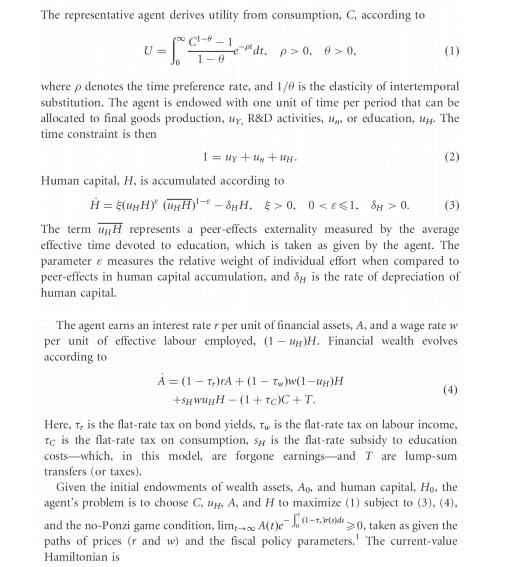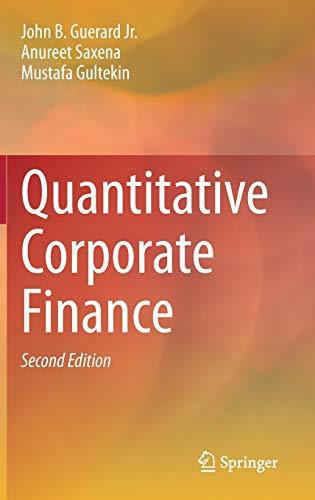Answered step by step
Verified Expert Solution
Question
1 Approved Answer
a) Complete the sentence above writing down the Hamiltonian. b) Apply the maximum principle and write down the conditions that it yields. The representative agent

a) Complete the sentence above writing down the Hamiltonian.
b) Apply the maximum principle and write down the conditions that it yields.
The representative agent derives utility from consumption, C, according to C--1 pedt. p>0, > 0 1- U-14 where p denotes the time preference rate, and 1/@ is the elasticity of intertemporal substitution. The agent is endowed with one unit of time per period that can be allocated to final goods production, uy, R&D activities, or education, up. The time constraint is then 1 = y + + (2) Human capital, H, is accumulated according to H = $(UHY (UH) -- 8H. > 0. 00. (3) The term WH represents a peer-effects externality measured by the avera effective time devoted to education, which is taken as given by the agent. The parameter e measures the relative weight of individual effort when compared to peer-effects in human capital accumulation, and 8y is the rate of depreciation of human capital. The agent earns an interest rater per unit of financial assets, A, and a wage rate w per unit of effective labour employed, (1 W). Financial wealth evolves according to A = (1 - 1)/A+ (1 - Tw(1-WH +5WH - (1 + Tc/C+T. Here, T, is the flat-rate tax on bond yields, T, is the flat-rate tax on labour income, Tc is the flat-rate tax on consumption, sy is the flat-rate subsidy to education costswhich, in this model, are forgone earningsand T are lump sum transfers (or taxes). Given the initial endowments of wealth assets, Am, and human capital, Ho, the agent's problem is to choose C, A, and H to maximize (1) subject to (3), (4), and the no-Ponzi game condition, lim Alte-La-Plak>0, taken as given the paths of prices (r and w) and the fiscal policy parameters. The current-value Hamiltonian is The representative agent derives utility from consumption, C, according to C--1 pedt. p>0, > 0 1- U-14 where p denotes the time preference rate, and 1/@ is the elasticity of intertemporal substitution. The agent is endowed with one unit of time per period that can be allocated to final goods production, uy, R&D activities, or education, up. The time constraint is then 1 = y + + (2) Human capital, H, is accumulated according to H = $(UHY (UH) -- 8H. > 0. 00. (3) The term WH represents a peer-effects externality measured by the avera effective time devoted to education, which is taken as given by the agent. The parameter e measures the relative weight of individual effort when compared to peer-effects in human capital accumulation, and 8y is the rate of depreciation of human capital. The agent earns an interest rater per unit of financial assets, A, and a wage rate w per unit of effective labour employed, (1 W). Financial wealth evolves according to A = (1 - 1)/A+ (1 - Tw(1-WH +5WH - (1 + Tc/C+T. Here, T, is the flat-rate tax on bond yields, T, is the flat-rate tax on labour income, Tc is the flat-rate tax on consumption, sy is the flat-rate subsidy to education costswhich, in this model, are forgone earningsand T are lump sum transfers (or taxes). Given the initial endowments of wealth assets, Am, and human capital, Ho, the agent's problem is to choose C, A, and H to maximize (1) subject to (3), (4), and the no-Ponzi game condition, lim Alte-La-Plak>0, taken as given the paths of prices (r and w) and the fiscal policy parameters. The current-value Hamiltonian isStep by Step Solution
There are 3 Steps involved in it
Step: 1

Get Instant Access to Expert-Tailored Solutions
See step-by-step solutions with expert insights and AI powered tools for academic success
Step: 2

Step: 3

Ace Your Homework with AI
Get the answers you need in no time with our AI-driven, step-by-step assistance
Get Started


